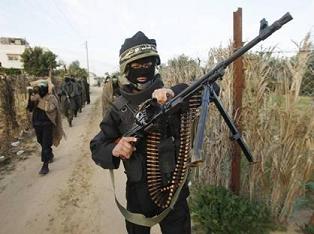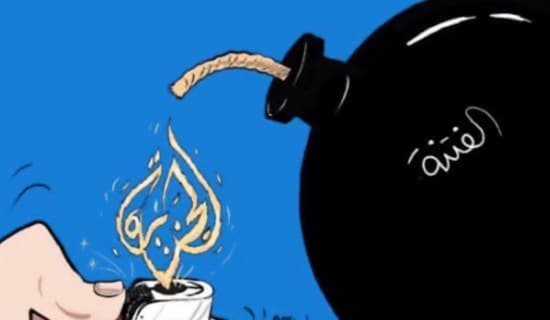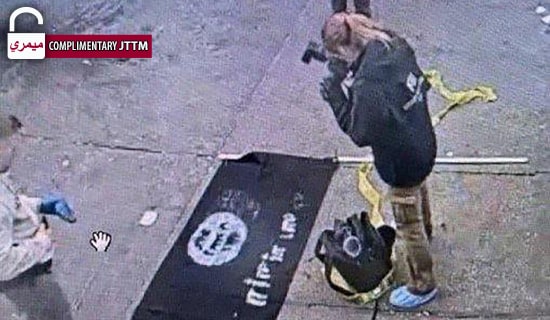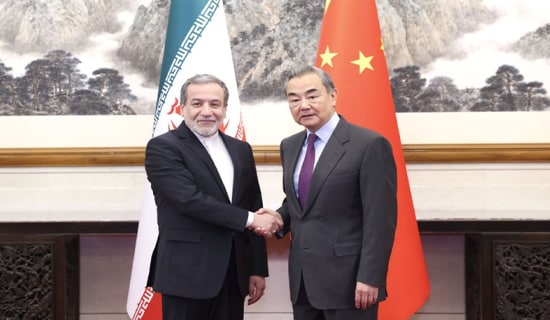Introduction
After the end of the Gaza war, Hamas largely stopped firing missiles at Israel, and forced the other Palestinian factions to observe the tahdiah (calm) as well – though both the factions and Hamas occasionally breach it. At the same time, Hamas has consistently clarified that it has not abandoned the resistance, proving this in practice in March-April 2011 when it participated in firing dozens of rockets at Israel, including one targeting an Israeli school bus. Hamas leaders continue to extol jihad, and the movement continues to arm itself, train, and fortify positions.
I. Tahdiah – With Intermittent Firing of Rockets
Hamas's efforts to maintain the tahdiah were evident, for example, in March 2, 2010, when Gaza police commander Abu 'Ubaida Al-Jarrah issued guidelines to all police elements in the Gaza Strip "to hunt down those who are firing missiles, to arrest them for investigation by the Hamas security apparatuses, and to punish them, treating them as perpetrators of serious offenses."[1] After Russia's foreign minister pressured Hamas to stop the firing of the missiles, in late March 2010, Hamas political bureau head Khaled Mash'al responded that the Hamas leadership supported the tahdiah and was not ratcheting up tensions, and that it would use appropriate means to prevent the firing of missiles.[2] In fact, several days later Mash'al ordered the leaders of Hamas's military wing to stop launching missiles and to prevent the Palestinian factions from doing so as well, "even if this involves the use of force."[3] Hamas also sought to coordinate positions with other factions, and on April 3, 2010, met with representatives of Islamic Jihad, the Popular Front for the Liberation of Palestine (PFLP), and the Democratic Front for the Liberation of Palestine (DFLP). All agreed to act in concert, in light of Israel's threats to respond to the firing of missiles.[4]
Hamas leaders sensed a need to explain their support for the ceasefire. Hamas political bureau deputy head Moussa Abu Marzouq said: "Hamas is interested in continuing the ceasefire with Israel, so that the latter will have no excuse to launch [another] military campaign against the Gaza Strip. There is agreement among the Palestinian factions to refrain from firing missiles at Israeli targets, but from time to time this agreement is violated."[5]
Particularly interesting was a statement by Hamas official Mahmoud Al-Zahhar, who called the firing of the rockets "suspicious," hinting that Israel was encouraging it. He said: "The enemy wants to portray the operations it is carrying out as self defense, by [saying that they are] a response to the firing of missiles from the Gaza strip."[6]
Though Fatah supports the tahdiah, it saw Hamas's suspension of the attacks on Israel as an opportunity to sting this movement. Fatah spokesman Ahmad 'Assaf said: "It is a positive development that Hamas now realizes the correctness of Palestinian Authority President Mahmoud 'Abbas's repeated call to save our people the troubles [caused by] Israeli reaction to the firing of missiles, to cease the firing, and to renew the tahdiah... [In the past,] the Hamas leaders preferred a regional agenda and narrow party interests to the supreme interests of the Palestinian people, and accused the [PA] leadership of treason and unbelief."[7]
Towards the end of 2010, Hamas loosened its grip on the various organizations, which caused a rise in the number of gunfire incidents and clashes with Israeli forces. The resulting tension, and Israel's retaliation, prompted the Hamas leaders to reiterate their commitment to the tahdiah and to enforce the ban on actions leading to escalation. In January 2011, the factions agreed to "protect the Palestinian people in Gaza and distance them from the danger of war," clarifying, however, that they were not announcing a tahdiah.[8] In mid-March 2011, Hamas deviated from this policy and participated in firing mortars and rockets at Israel.[9] In this case, too, the firing of rockets stopped after a few days, and an agreement was reached with the factions to uphold the tahdiah, providing that Israel ceased its attacks on Gaza. In response to the assassination of fighters from Hamas' military wing, the movement renewed the firing of rockets, and claimed responsibility for the firing of a rocket on an Israeli school bus, which resulted in the death of a teenage boy.
Hamas's actions reflect a duality within the movement. On one hand, Hamas wishes to maintain the tahdiah in order to avoid an Israeli retaliation that would cause it severe damage and undermine its control over Gaza. This policy is led by Hamas's political leadership inside Gaza. On the other hand, Hamas is trying to establish a new paradigm, whereby any harm to its members triggers an automatic response in the form of rocket fire, so that its members will be protected from harm even while preparing terrorist attacks or abductions of Israelis. This policy is led by the head of the military wing, Ahmad Al-Ja'bari. The calm that has prevailed in the recent weeks indicates that Hamas has the capability to prevent the firing of rockets into Israel.
II. Hamas Remains Committed to Resistance and Jihad
Hamas's tahdiah was perceived in the Gaza Strip as a tactical move – a time-out for regrouping in preparation for the next round of activity against Israel. Hamas website columnist Yasser Al-Za'atra wrote: "It is almost certain that the Palestinian arena will yet return to the path of the resistance, as it did after the misguided Oslo campaign (1993-2000)."[10] 'Abd Al-Bari 'Atwan, editor of the London daily Al-Quds Al-'Arabi, assessed the situation in much the same way: "Hamas never ultimately relinquished the resistance, and perhaps the current hudna [ceasefire] is temporary, like those that preceded it – but its leaders must realize that the patience of some of the Islamic groups has a short fuse, and that some yearn for jihad."[11]
The Hamas leaders themselves have continued to speak in pro-resistance and pro-jihad terms. In response to the continued construction in Jerusalem, and to the March 16, 2010 inauguration of the Hurva Synagogue in the Old City, Palestinian Legislative Council deputy speaker Ahmad Baher (of Hamas) called on the resistance factions to "strike a hard military blow against the Israeli occupation."[12] A Hamas communiqué stated, "Resistance is a strategic choice... and the [Hamas] movement clings to jihad." The communiqué also called for the Arab Peace Initiative to be rescinded.[13]
Also glorifying the resistance was the Gaza municipality itself; it named a city square after Rim Al-Riyashi, who carried out a suicide bombing in 2004.[14]
The atmosphere of preparation for the continuation of the struggle was also evident in Gaza's education system. In a play at a commencement ceremony in Gaza, children wore the uniforms of the 'Izz Al-Din Al-Qassam Brigades, Hamas's military wing, and "fought" "Israeli soldiers," "kidnapping" one of them.[15] At a Hamas ceremony honoring families of martyrs in Jabalya, the spokesman for the families said: "We are ready to sacrifice our children, ourselves, and our money to declare 'there is none but Allah,' and to liberate the homeland."[16]
The most obvious manifestation of militant education was reported by the Egyptian daily Al-Ahram, in a story that described the militant atmosphere at the Hamas summer camps, in comparison to the atmosphere in the UNRWA summer camps: "While the children in the UNRWA [camps] enjoy painting, swimming, and dancing to folk music, other children march in military parades, bearing the photos of Hamas prisoners and martyrs and shouting slogans of the resistance. These are the children in the Hamas camps. 'Our Al-Aqsa, our prisoners, freedom will come' – these are the slogans shouted by children aged seven through 12 in a military march. 'No toys or rowdiness,' as one of the camp leaders put it... The children live in an atmosphere of military mobilization and preparation for resistance [in times of both] peace and war. In one camp, held at the Sheikh Radwan mosque, the setting and the training create an atmosphere of war and resistance. Photos of masked men with guns festoon the camp, [which looks like] a military base."[17]
Hamas' Ministry of Prisoners' Affairs officially endorsed the cause of kidnapping Israeli soldiers, when it announced that it supported a campaign, declared by the Wa'ed Society in Gaza, promising a million Jordanian dinars "for anyone who kidnaps an Israeli soldier to exchange him for Palestinian prisoners."[18] Isma'il Haniya's advisor Mustafa Al-Kanu' said that the Palestinian prisoners would only be liberated by kidnapping more Israeli soldiers.[19] Hamas's military wing, the 'Izz Al-Din Al-Qassam Brigades, have pledged to continue their efforts to achieve this.[20]
III. Training, Arming and Fortifying Positions
Hamas is continuing to prepare for a military confrontation by building fortifications, smuggling weapons into Gaza, and training its fighters. At a meeting with Arab party leaders at a Damascus conference, Khaled Mash'al revealed, in a rare moment of candor, that "outwardly, there is talk in Gaza about reconciliation and building, but, actually, most of the funds and efforts are allocated to the resistance and to military preparations. We deal with resistance."[21]
A website close to Fatah reported that Hamas militias had set heavy explosive charges near densely populated buildings in Gaza in areas distant from the Israeli border – leading to great resentment, verbal clashes, and sometimes brawls between residents and Hamas activists.[22]
On the Hamas fortifications, Dr. Fayez Abu Shamala, columnist for a Hamas-affiliated website, wrote that Hamas had thousands of tunnels across the length and breadth of the Gaza Strip.[23]
The 'Izz Al-Din Al-Qassam Brigades described their preparations for conflict and their desire for martyrdom: "In the dim light of the moon sits a Hamas fighter, beneath a tree with tangled branches. He draws away from his comrades, takes a Koran out of his rucksack, and begins to read aloud in a pleasant voice. Another [fighter] calls on Allah to grant him martyrdom. Yet another waits at a distance for the enemy to come, so that he can surprise him. On the other side, an engineering unit of the Al-Qassam Brigades prepares to set an explosive device, in advance of a Zionist attack, so as to sow death [among the passengers] of the vehicle of the Zionist enemy... In another area, civil defense members prepare to set [antiaircraft] ground missiles, for downing enemy planes in Gaza's skies... In a high area, a sniper corps is getting ready to position its weapon[s] in order to strike at Zionist enemy soldiers if they infiltrate anywhere. Among the trees with tangled branches, a group of artillerymen prepare to set a mortar for countering any foolish move by the enemy, or any advance of special [Israeli] troops anywhere."[24]
A Gaza fighter (source: paldf.net, June 13, 2010)
Following the increased efforts by Israel and Egypt in the aftermath of the Gaza war to prevent weapons from being brought into Gaza, senior Hamas official Ahmad Yousuf stated: "Resistance is a legitimate right, as are the weapons [of the resistance]; therefore, the resistance will obtain weapons in all possible ways in order to continue its activity, via the tunnels or not… [even] from beneath the earth."[25] Hamas leader Mahmoud Al-Zahhar said, "My movement [now] has better weapons than it had on the eve of the Gaza war."[26] In July 2010, Hamas Interior Minister Fathi Hammad announced that his ministry was planning to introduce voluntary conscription to the Hamas army in Gaza, followed by mandatory conscription.[27]
In early 2011, the Hamas police announced that Gaza residents would be required to obtain a permit for firearms for self-defense. The announcement stressed that this regulation did not apply to the weapons of the resistance, which were legal without a permit.[28]
Hamas's military activity was not limited to Gaza. In May 2010, PA President Mahmoud 'Abbas disclosed that "every day, we seize large quantities of arms [in the West Bank]."[29] In April 2011, officials in the PA security apparatuses announced the discovery of a Hamas-run mosque in the West Bank where explosives were manufactured and stored,[30] and a website close to Fatah said that the security apparatuses had discovered a large facility for manufacturing and storing explosives in Nablus.[31]
Justifying Hamas's activity in the West Bank, Mahmoud Al-Zahhar said, "Gaza is [already] liberated; [now], the PA security apparatuses must give us a free hand to liberate the West Bank and Jerusalem. There must be missiles fired and resistance from the West Bank. Are the firing of missiles and [waging of] resistance demanded only in Gaza?"[32]
The Kuwaiti anti-Syrian daily Al-Siyassa reported that in late 2009, five Hamas members and two Iranian Islamic Revolutionary Guards Corps (IRGC) members were killed at a Hamas base near Damascus while training in assembling and disassembling Iranian long-range rockets, meant for smuggling into Gaza via the tunnels.[33]
Lebanon is another Hamas training arena. Lebanese sources reported that an investigation of an explosion in a Hamas center in Lebanon showed that it had occurred during training with live ammunition.[34]
Endnotes:
[1] Wafa1.ps, March 2, 2010.
[2] Al-Hayat Al-Jadida (Palestinian Authority), April 2, 2010.
[3] Palpress.ps, April 8, 2010.
[4] Al-Quds (Jerusalem), April 4, 2010.
[5] Alaahd.com, April 13, 2010.
[6] Maannews.net, March 21, 2010.
[7] Maannews.net, April 3, 2010.
[8] Alresalah.ps, January 13, 2011.
[9] Palestine-info.info, March 19, 2011.
[10] Paltoday.com, August 15, 2009.
[11] Paltoday.com, August 17, 2009.
[12] Al-Hayat Al-Jadida (Palestinian Authority), March 16, 2010.
[13] Palestine-info.info, December 12 and 13, 2009.
[14] Al-Ayyam (Palestinian Authority), March 24, 2010. On January 14, 2004, Rim Al-Riyashi, mother of two, blew herself up at the Erez checkpoint between Israel and Gaza, killing four Israelis and wounding ten.
[15] Maannews.net, May 30, 2010.
[16] Al-Quds (Jerusalem,) January 7, 2010.
[17] Al-Ahram (Egypt), June 30, 2010.
[18] Maannews.net, November 19, 2009.
[19] Al-Ayyam (Palestinian Authority), March 1, 2011; safa.ps, February 28, 2011.
[20] Alqassam.ps, August 8, 2011.
[21] Paltimes.net, November 14, 2009.
[22] Alaahd.com, January 13, 2010.
[23] Palestine-info.info, June 7, 2010.
[24] Alqassam.ps, July 4, 2010.
[25] Al-Sharq Al-Awsat (London), January 25, 2009.
[26] Palestine-info.info, April 18, 2009.
[27] Amad.ps, July 28, 2010.
[28] Maannews.net January 5, 2011.
[29] Al-Sharq Al-Awsat (London), May 6, 2010.
[30] Al-Quds Al-Arabi, (London), April 13, 2009.
[31] Palvoice.com, April 29, 2010.
[32] Al-Quds (Jerusalem), June 20, 2010.
[33] Al-Siyassa (Kuwait), November 15, 2009.
[34] Al-Sharq Al-Awsat (London), January 6, 2010.





